- Words and Their Stories - Bethena Concert Waltz by Joplin
- People in America - Prelude II by Gershwin
- This Is America - Simple Gifts by Copland
- Explorations - All Souls Waltz by Nakai / Kater
- American Mosaic - The Fourth Door by Davis
- American Stories - Warm Valley by Ellington
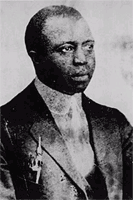 Scott Joplin, the "King of Ragtime Composers", in 1904 was near the peak of his career when his young bride, Freddie Alexander of Little Rock, Arkansas died just 2 months after their marriage. The existance of Freddie was almost forgotten. None of Joplin’s acquaintances who had been interviewed for eariler biographies had ever referred to her. Edward A. Berlin in his recently published Joplin biography, "King of Ragtime" devotes an entire chapter to Freddie. His meticulous research proves her existence and brings to light several facts about her. I quote: "It is strange that none of Joplin’s associates who were interviewed in later years, including his widow Lottie and his friends Arthur Marshall and Sam Patterson, mentioned Freddie. Perhaps the brevity of the marriage made it insignificant in the minds of his friends.But Freddie was not insignificant to Joplin, for some years later he was to memorialize her in his most ambitious work [his opera "Treemonisha"]".
Scott Joplin, the "King of Ragtime Composers", in 1904 was near the peak of his career when his young bride, Freddie Alexander of Little Rock, Arkansas died just 2 months after their marriage. The existance of Freddie was almost forgotten. None of Joplin’s acquaintances who had been interviewed for eariler biographies had ever referred to her. Edward A. Berlin in his recently published Joplin biography, "King of Ragtime" devotes an entire chapter to Freddie. His meticulous research proves her existence and brings to light several facts about her. I quote: "It is strange that none of Joplin’s associates who were interviewed in later years, including his widow Lottie and his friends Arthur Marshall and Sam Patterson, mentioned Freddie. Perhaps the brevity of the marriage made it insignificant in the minds of his friends.But Freddie was not insignificant to Joplin, for some years later he was to memorialize her in his most ambitious work [his opera "Treemonisha"]".
"Bethena" was the first Joplin work published after the death of Freddie. The piece was dedicated to Mr. & Mrs. Dan Davenport. I again quote Berlin; "This is an unusual dedication. Davenport was not a prominent performer who could showcase Joplin’s music. Nor was he a person of influence or wealth, one who could have helped Joplin’s career or commissioned music. So why should Joplin dedicate this piece to Davenport or his wife?"
"The dedication may have had personal significance. Since this is Joplin’s first copyrighted work (March 6, 1905) since Freddie’s death. I think the Davenports might have helped Joplin through some difficult times, and the dedication was his way of showing appreciation. Supporting the idea that "Bethena" is connected with Freddie, or at least reflects Joplin’s mood at the time, is that the music is sadly poignant. It is decidedly not a cheerful, merry waltz, and in this respect contrasts with all of Joplin’s other waltzes."
"But then, what is the significance of the title? "Bethena" is an unusual name. Was there a Bethena? If so, is she the beautiful woman pictured on the cover? Or (and this is highly speculative) is this a picture of Freddie." Since Freddie was her given name, could Bethena be her nickname? All speculation aside, Bethena is an enchanting piece and is amoung the greatest of ragtime waltzes.
Download Bethena Concert Waltz (.mid format 21.9KB)
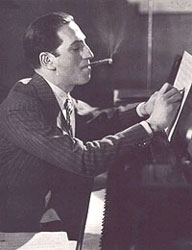 George Gershwin was born in Brooklyn, New York, September 26, 1898. He began his musical training at thirteen. At fifteen he left high school to work as a pianist and song-plugger for musical publishers. He was soon writing songs. "Swanee", introduced by Al Jolson, brought Gershwin his first real fame. But it was George and his older brother, Ira, who became the dominant Broadway songwriters to emerge during the 20s, creating a ceaseless flow of brisk, infectious rhythms and affectingly poignant ballads. Working together they fashioned the words to fit melodies with a "glove-like" fidelity. This extraordinary collaboration led to a succession of 22 musical comedies, among them Lady Be Good (1924), Oh, Kay! (1926), Funny Face (1927), Strike Up the Band (1927 & 1930), Girl Crazy (1930) and Of Thee I Sing (1931) - the first musical comedy to win a Pulitzer Prize.
George Gershwin was born in Brooklyn, New York, September 26, 1898. He began his musical training at thirteen. At fifteen he left high school to work as a pianist and song-plugger for musical publishers. He was soon writing songs. "Swanee", introduced by Al Jolson, brought Gershwin his first real fame. But it was George and his older brother, Ira, who became the dominant Broadway songwriters to emerge during the 20s, creating a ceaseless flow of brisk, infectious rhythms and affectingly poignant ballads. Working together they fashioned the words to fit melodies with a "glove-like" fidelity. This extraordinary collaboration led to a succession of 22 musical comedies, among them Lady Be Good (1924), Oh, Kay! (1926), Funny Face (1927), Strike Up the Band (1927 & 1930), Girl Crazy (1930) and Of Thee I Sing (1931) - the first musical comedy to win a Pulitzer Prize.
Over the years, Gershwin songs have also been used in numerous films and in the award-winning stage musicals, My One and Only (1983) and Crazy For You (1992). Crazy For You is loosely based on Girl Crazy, with a new libretto by Ken Ludwig and has an impressive roster of George and Ira songs including two previously unpublished songs.
Prelude II begins with a series of bass chords. They tread smoothly across the lower octaves of the keyboard in a shuffling, rubato step. I pedal them all, allowing them to mingle for only a moment. Slowly, they rise and fall with measured motion. Each phrase lingers longer than it should, as if it had stumbled. The notes conjure a dim evening in a smoky alleyway. Little traffic passes at this hour; the streetcars have stopped. Perhaps, a disoriented pedestrian wanders by, or an occasional vehicle jars upon the uneven cobblestones. Faint lights burn here and there in the grimy windows, like the wary, red eyes of untamed beasts. From the distance floats the muted wailing of a child. The garish neon of a cabaret generates flickering shadows, outlines of garbage cans and cardboard boxes, tinged in yellow-orange. A saxophone emits harsh tones from within the bar. Odors of frying onions and stale beer mingle with the faint scent of urine; they rise from the street in the damp mist. A few streetlights struggle valiantly to ward off the imminent gloom. The sultry chords continue uninterrupted.
Then, a quiet strain appears in the treble, two notes alternating in legato succession. A prostitute has emerged from the shadows into the soft cone illuminating the street-corner. At first, she is uncertain. The melody pauses and then repeats, then pauses again. The woman becomes more confident; she steps full into the light. She struts about, as if practicing her role. She raises her skirt slightly to reveal a stout thigh.
She is not a young woman, and her thick makeup does not cover the lines in her face. Necessity and hunger drive her to this corner each night. Under her tight skirt, she wears tawdry black stockings; her blouse does not hide her cleavage. Her perfume a nnounces its uncertain quality with a powerful scent. She seems profoundly weary as she leans against the lamppost. Now, she rummages in her bag and makes a quick motion; a match flares, and she lights a limp cigarette. She takes a long drag, and a brief smile crosses her face.
A dense gray blankets the midnight sky. The streetwalker resumes pacing back and forth on the curb. The melody descends into the bass, as two men pass by. They are discussing intercourse in vulgar, drunken tones. The woman flaunts her legs with deliberate grace. However, they ignore her solicitations and vanish into the darkness. The night again engulfs her, the blind mist, the piercing saxophone, the faint stench of urine.
Another prostitute joins her. They walk in unison to and fro on the corner. All the while, they engage in idle conversation; their quiet voices repeating the same refrain again and again as they continue to pace. They light cigarettes and inhale deeply . The smoke curls from their nostrils and from the incandescent butts resting between their fingers. They discuss their trade and smoke. They hear a man approaching and begin to ply their wares. He slows and stops.
Suddenly demure, the women offer what they have to sell. The man inspects them, his eyes critically tracing their voluptuous curves. He talks with them awhile before inquiring their price and negotiating. He selects one. As he caresses her, the two retire into the dim shadows. She yields in quiet consummation.
Thick gloom besieges the weak street-lamp which seems almost ready to capitulate. The saxophone no longer sounds. No child moans in the distance. The flickering cabaret ceases to shine. Only the dense night and the unpleasant aromas remain. The mourn ful chords continue. A quiet strain reappears in the treble.
The prostitute is again alone. Profoundly weary, she leans against the lamppost. In a deliberate attempt to seduce a nonexistent suitor, she lifts her skirt and displays her fat thighs. Now, a match flares, and she lights a limp cigarette. Smoke curls from her nostrils, and a brief smile crosses her face.
A sudden gust of wind carries an assortment of creased newspapers and trash down the street. The hot air swirls about the woman’s head, making the cigarette burn fiercely. Then, just as suddenly, it is still.
The night draws to a close; the streetwalker ceases to pace. Another man passes through in the bassline. The sun begins to tinge the ruddy sky with its brilliance. A slow, arpeggio ascends the keyboard, scaling three octaves until it reaches a sustained, soprano chord. A moment later, a discordant seventh joins the other notes. Finally, a bass C-sharp quietly resolves the dissonance as the chord fades away. Then silence.
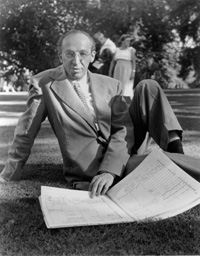 Aaron Copland, one of America’s greatest composers, was the fifth child born into a family of Russian-Jewish immigrants in Brooklyn, New York. He was born on November 14, 1900. However, it was not until he reached his teens that Copland began to show an interest in music. He learned to play the piano from his older sister Laurine, and in less than one year, Copland had learned everything she could teach him. Following much pestering of his father, Copland was allowed to take formal lessons. After attending his first concert at age 15, Copland decided to become a composer.
Aaron Copland, one of America’s greatest composers, was the fifth child born into a family of Russian-Jewish immigrants in Brooklyn, New York. He was born on November 14, 1900. However, it was not until he reached his teens that Copland began to show an interest in music. He learned to play the piano from his older sister Laurine, and in less than one year, Copland had learned everything she could teach him. Following much pestering of his father, Copland was allowed to take formal lessons. After attending his first concert at age 15, Copland decided to become a composer.
Upon graduating high school, Copland studied harmony and counterpoint through a correspondence course, a very difficult way to learn music. He was then referred to Rubin Goldmark, who was a specialist in harmony. Copland dreamt of studying music in France, and for the next several years, he saved his money and continued to practice. In 1920, Copland was granted a scholarship, and in the summer of 1921, he traveled to the American Conservatory at Fontainebleau.
In France, Copland studied with Nadia Boulanger and became her first American student in composition. Copland studied in France for three years, then returned to New York with a commission from his teacher. While working as a pianist in a Pennsylvania resort, Copland composed the Symphony for Organ and Orchestra, for Boulanger’s American appearances. The work premiered at Carnegie Hall with the New York Symphony Orchestra, under conductor Walter Damrosch.
After his successful debut, Copland spent several months composing in New Hampshire. His early compositions were influenced by jazz rhythms. He described this style as symphonic jazz. Music for the Theater (1925) and Piano Concerto (1926) were written during this period of Copland’s career. During this time, Copland was awarded the first monetary grant from the Guggenheim Memorial Foundation, enabling him to continue his work.
Copland soon moved into a more austere and abstract style. Piano Variations (1930) and Statements for Orchestra (1933-35) reflect this change. Copland made another abrupt style change in the mid-1930s with a move towards simplicity and melody, in an effort to be more accessible to the general public. He wanted to bring more music to more people.
The next 10 years were Copland’s most productive. Using elements of American folk music, Copland produced lyrical compositions such as the ballets Billy the Kid (1938), Rodeo (1942), and Appalachian Spring (1944). He composed music for films, including Of Mice and Men (1937), Our Town (1940), and The Heiress (1949). Copland also produced two works for high school students called The Second Hurricane (1937) and An Outdoor Overture (1938). Additional works of this period include Lincoln Portrait (1942), Third Symphony (1946), and El salon Mexico, an orchestral piece based on Mexican folk music.
Copland again returned to a more austere style in the 1950s. The Piano Fantasy (1957); Connotations (1962), which was commissioned for the opening of Lincoln Center in New York City; and Inscape (1967), reflect the 12-tone style popularized by composer Arnold Schoenberg. These works were not as well received as Copland’s previous works.
In the 1970s, Copland virtually stopped composing, although he continued to conduct. His final work, Proclamation (1982), was performed during a concert celebrating his 85th birthday. Aaron Copland died on December 2, 1990.
In addition to composing and conducting, Copland wrote several books, including What to Listen for in Music (1939), Music and Imagination (1952), and Copland on Music (1960). He was influential in promoting contemporary composers and organized numerous musical events. Copland received more than 30 honorary degrees. He was a distinguished teacher at the Berkshire Music Center, and in 1945, he won the Pulitzer Prize for Music.
Download "Simple Gifts" (.mid format 6.5KB)
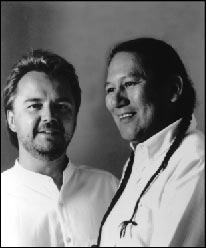 Part One
Part One
Of Navajo-Ute heritage, R. Carlos Nakai is the world’s premiere performer of the Native American flute. Originally trained in classical trumpet and music theory by Ronald K. Bowen and Birley R. Gardner, Nakai was given a traditional cedar wood flute as a gift and challenged to see what he could do with it. His first album, Changes, was released on the Canyon Records label in 1983 and since then he has released over sixteen more recordings with Canyon. He has also recorded for Silverwave Records and Celestial Harmonies. He has contributed music for the Columbia Pictures version of Geronimo, the TNT series, How the West Was Lost, and has scored music for the IMAX production, Zion. The great American choreographer, Martha Graham, used music from Cycles for one of her last dance works, "Night Chant."
Nakai has performed throughout the world leading the renaissance of the Native American flute by bringing the haunting, timeless sound of the traditional cedar flute to new listeners and into new musical styles. In addition to his solo appearances in the United States, Canada, Europe and Japan, Nakai has worked with guitarist William Eaton and pianist Peter Kater and founded the ethnic jazz ensemble, Jackalope. Nakai has worked with such diverse musical forces as the Wind Travelin’ Band, a traditional Japanese group, and has performed as a member of Tos, a classical ensemble led by James DeMars. He has performed before sold out audiences with the Phoenix Symphony, Tucson Symphony, San Juan Symphony, California Symphony and the Saskatoon Symphony.
In 1992, Nakai received one of the highest awards the state of Arizona can bestow, the Governor’s Art Award. In 1994 he was a Grammy finalist for his Ancestral Voices album with William Eaton and was awarded an honorary doctorate from Northern Arizona University. In 1995 the First Americans in the Arts gave him their first award for musical achievement for his career of performance, composition and education.
Nakai has earned a Master’s Degree in American Indian Studies from the University Arizona. Nakai sees his role as a performer of the traditional flute not to reiterate the traditional sounds but to find new avenues of expression for the cultures of native peoples.
Part Two
Pianist-composer Peter Kater is known for his scores for television, film and theater, as well as for his own recordings of light jazz and new age music. Born in Germany, Kater moved from Munich to New Jersey when he was four. He began piano lessons three years later, and studied classical music until taking up rock & roll in his early teens. At the age of 18, Kater moved to Boulder, CO, where he played improvised music and lived for over a decade before moving to rural Virginia, where he built EarthSea Studios. Until the opening of Earthsea in early 1997, Kater had recorded exclusively for the Silverwave label, starting with his debut release, Spirit, in 1983. He went on to release over 20 albums on Silverwave, including highly successful collaborations with R. Carlos Nakai that resulted in, among others, How the West Was Lost, Volumes 1 and 2 and Migration (1992), which also received the NAIRD Best New Age Album Indie Award. Several of Kater and Nakai’s recordings have risen to the Top 20 of Billboard’s New Age chart, and a few of Kater’s own releases -- which range from solo to quintet line-up -- have charted in the Top 25. Since starting his EarthSea label, Kater has released albums including 1998’s Compassion and another collaboration with Nakai entitled Winds of Devotion (1999). -- Joslyn Layne, All Music Guide
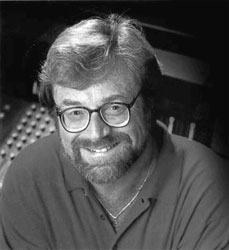 Louis Davis, Jr. was born into a family of musicians in rural Ohio and began his musical training at age 4, with his grandmother as his first piano teacher. He composed his first piece, a four-part chorale about his dog Stormy at age 6. By the time Davis entered the University of Michigan music school, he had found his true musical loves the bassoon and percussion. He graduated in 1969 as a classically trained bassoonist who also played percussion in the famous University of Michigan Marching Band.
Louis Davis, Jr. was born into a family of musicians in rural Ohio and began his musical training at age 4, with his grandmother as his first piano teacher. He composed his first piece, a four-part chorale about his dog Stormy at age 6. By the time Davis entered the University of Michigan music school, he had found his true musical loves the bassoon and percussion. He graduated in 1969 as a classically trained bassoonist who also played percussion in the famous University of Michigan Marching Band.
After touring with the renowned Norman Luboff Choir, and teaching young people to love music, Davis took a new career path that would change his life forever. He began writing advertising jingles for an Omaha ad agency, including a series of spots about fictional truck driver C.W. McCall and his waitress girlfriend Mavis at the Old Home Filler Up and Keep On Truckin’ Cafe. What began as just another jingle for a bread company became a national phenomenon radio listeners called stations to request the commercials be played as if they were pop tunes, and the TV spots were listed in TV Guide. With fellow ad executive Bill Fries, Davis accepted a recording contract, and went on to produce blockbusters such as the 1975 hit "Convoy," which sold more than a million copies within 2 months, and eventually sold 10 million copies. It’s not surprising that Davis was named Country Music Writer of the Year in 1976.
In the meantime, Davis explored new ways of expressing music and discovered a style he calls "18th Century classical rock." He says "I don’t believe in all-acoustic or all-electronic, all-digital or all-analog. My place is where they meet." He called his band Mannheim Steamroller, which is the name of an 18th-Century musical technique that we know today as the crescendo.
This exploration resulted in an album called Fresh Aire, which Davis tried and failed to sell to mainstream record companies. So innovative was this musical style that it did not fit into any of the standard industry categories. Innovative music demanded innovative marketing, so Davis founded his own record label, American Gramaphone, and distributed the albums not to record stores but to audio showrooms. Used to demonstrate home stereo equipment, Fresh Aire became an audiophile hit when listeners said "I like this turntable, but I really want the music playing on it." Orders flooded in and records sold from the U.S. to Japan to Germany.
Since that time Davis has produced seven more Fresh Aire albums, each inspired by the themes of nature, science and ancient mythology. Fresh Aire VII, which Davis describes as "an exploration of the nature of the number 7" was awarded the Grammy for Best New Age Recording in 1990. Davis released the final album in the series in August 2000, titled Fresh Aire 8, on the theme of infinity.
More than once Davis has turned his talents to aid a worthy project. When devastating fires ravaged Yellowstone National Park in 1988 Davis created a two-year concert tour and another gold album called Yellowstone: The Music of Nature. More than $500,000 was raised from the project to rebuild structures in the park, making Davis the largest private donor in the history of the National Park Service.
In 1984 Davis once again called conventional music industry wisdom into question. He announced that his next project would be a Christmas album and was told that he would certainly fail. Infusing new life into traditional Christmas music "Mannheim Steamroller Christmas" has sold more than six million copies and was nominated for a Grammy Award. With subsequent albums "A Fresh Aire Christmas," "Christmas in the Aire" and "Christmas Live," Mannheim Steamroller has sold more than 18 million Christmas albums. Davis doesn’t put much stock in conventional wisdom.
Over his 27-year career, Chip Davis has sold more than 34 million albums.
He and his wife Trisha live outside Omaha, Nebraska with their three children, Kelly, Evan and Elyse. In the living room is the piano his grandmother first taught him to play.
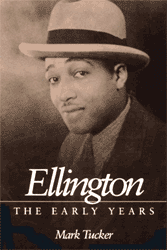 By the time of his passing, Duke Ellington was considered amongst the world’s greatest composers and musicians. The French government honored him with their highest award, the Legion of Honor, while the government of the United States bestowed upon him the highest civil honor, the Presidential Medal of Freedom. He played for the royalty and for the common people and by the end of his fifty-year career, he had played over 20,000 performances worldwide. He was The Duke, Duke Ellington.
By the time of his passing, Duke Ellington was considered amongst the world’s greatest composers and musicians. The French government honored him with their highest award, the Legion of Honor, while the government of the United States bestowed upon him the highest civil honor, the Presidential Medal of Freedom. He played for the royalty and for the common people and by the end of his fifty-year career, he had played over 20,000 performances worldwide. He was The Duke, Duke Ellington.
Edward Kennedy Ellington was born into the world on April 29, 1899 in Washington, D.C. Duke’s parents Daisy Kennedy Ellington and James Edward Ellington served as ideal role models for young Duke and taught him everything from proper table manners to an understanding of the emotional power of music. Duke’s first piano lessons came around the age of seven or eight and appeared to not have that much lasting effect upon him. It seemed as if young Duke was more inclined to baseball at a young age. Duke got his first job selling peanuts at Washington Senator’s baseball games. This was the first time Duke was placed as a "performer" for a crowd and had to first get over his stage fright. At the age of fourteen, Duke began sneaking into Frank Holliday’s poolroom. His experiences from the poolroom taught him to appreciate the value in mixing with a wide range of people. As Duke’s piano lessons faded into the past, Duke began to show a flare for the artistic. Duke attended Armstrong Manual Training School to study commercial art instead of an academically-oriented school. Duke began to seek out and listen to ragtime pianists in Washington and during the summers, where he and his mother vacationed in Philadelphia or Atlantic City. While vacationing in Asbury Park, Duke heard of a hot pianist named Harvey Brooks. At the end of his vacation Duke sought Harvey out in Philadelphia where Harvey showed Duke some pianistic tricks and shortcuts. Duke later recounted that, "When I got home I had a real yearning to play. I hadn’t been able to get off the ground before, but after hearing him I said to myself, ‘Man you’re going to have to do it.’" Thus the music career of Duke Ellington was born.
Duke was taken under the wings of Oliver "Doc" Perry and Louis Brown who taught Duke how to read music and helped improve his overall piano playing skills. Duke found piano playing jobs at clubs and cafes throughout the Washington area. Three months shy of graduation, Duke dropped out of school and began his professional music career.
In late 1917, Duke formed his first group: The Duke’s Serenaders. Between 1918 and 1919, Duke made three significant steps towards independence. First, he moved out of his parents’ home and into a home he bought for himself. Second, Duke became his own booking agent for his band. By doing so, Ellington’s band was able to play throughout the Washington area and into Virginia for private society balls and embassy parties. Finally, Duke married Edna Thompson and on March 11, 1919, Mercer Kennedy Ellington was born.
In 1923, Duke left the security that Washington offered him and moved to New York. Through the power of radio, listeners throughout New York had heard of Duke Ellington, making him quite a popular musician. It is also in that year that Duke made his first recording. Ellington and his renamed band, The Washingtonians, established themselves during the prohibition era by playing at places like the Exclusive Club, Connie’s Inn, the Hollywood Club (Club Kentucky), Ciro’s, the Plantation Club, and most importantly the Cotton Club. Thanks to the rise in radio receivers and the industry itself, Duke’s band was broadcast across the nation live on "From the Cotton Club." The band’s music along with their popularity spread rapidly.
In 1928, Ellington and Irving Mills signed an agreement in which Mills produced and published Ellington’s music. Recording companies like Brunswick, Columbia, and Victor came calling. Duke’s band became the most sought after band in the United States and even throughout the world.
Some of Ellington’s greatest works include, Rockin’ in Rhythm, Satin Doll, New Orleans, A Drum is a Women, Take the "A" Train, Happy-Go-Lucky Local, The Mooche, and Crescendo in Blue.
Duke Ellington and his band went on to play everywhere from New York to New Delhi, Chicago to Cairo, and Los Angeles to London. Ellington and his band played with such greats as Miles Davis, Cab Calloway, Dizzy Gillespie, Ella Fitzgerald, Tony Bennett, and Louis Armstrong. They entertained everyone from Queen Elizabeth II to President Nixon. Before passing away in 1974, Duke Ellington wrote and recorded hundreds of musical compositions, all of which continue to have a lasting effect upon people worldwide for a long time to come.
Download Warm Valley (.mid format ,21.0KB) - DukeEllington’s offical site
- Words and Their Stories - Bethena Concert Waltz by Joplin
- People in America - Prelude II by Gershwin
- This Is America - Simple Gifts by Copland
- Explorations - All Souls Waltz by Nakai / Kater
- American Mosaic - The Fourth Door by Davis
- American Stories - Warm Valley by Ellington